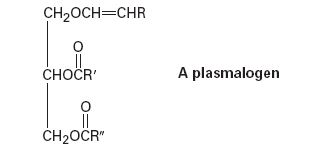
Bundle: Organic Chemistry, 9th, Loose-Leaf + OWLv2, 4 terms (24 months) Printed Access Card
9th Edition
ISBN: 9781305701021
Author: John E. McMurry
Publisher: Cengage Learning
expand_more
expand_more
format_list_bulleted
Concept explainers
Textbook Question
Chapter 27.SE, Problem 22AP
The plasmalogens are a group of lipids found in nerve and muscle cells. How do plasmalogens differ from fats?

Expert Solution & Answer
Want to see the full answer?
Check out a sample textbook solution
Students have asked these similar questions
In a photochemical reaction, how is the rate of the process related to its quantum yield?
Primary and global quantum yields in photochemistry. Define them and give their formulas. Differentiate between them.
Help me solve my HW
Chapter 27 Solutions
Bundle: Organic Chemistry, 9th, Loose-Leaf + OWLv2, 4 terms (24 months) Printed Access Card
Ch. 27.1 - Carnauba wax, used in floor and furniture...Ch. 27.1 - Draw structures of glyceryl tripalmitate and...Ch. 27.2 - Prob. 3PCh. 27.2 - Write the saponication reaction of glyceryl...Ch. 27.4 - Prob. 5PCh. 27.5 - Prob. 6PCh. 27.5 - Prob. 7PCh. 27.6 - Draw the following molecules in chair...Ch. 27.6 - Lithocholic acid is an A–B cis steroid found in...Ch. 27.7 - Prob. 10P
Ch. 27.SE - Prob. 11VCCh. 27.SE - Propose a biosynthetic pathway for the...Ch. 27.SE - Identify the following fatty acid, and tell...Ch. 27.SE - Prob. 14MPCh. 27.SE - Prob. 15MPCh. 27.SE - Prob. 16MPCh. 27.SE - Prob. 17APCh. 27.SE - Fats can be either optically active or optically...Ch. 27.SE - Prob. 19APCh. 27.SE - Show the products you would expect to obtain from...Ch. 27.SE - Draw a Newman projection along the C2-C3 bond of...Ch. 27.SE - The plasmalogens are a group of lipids found in...Ch. 27.SE - Prob. 23APCh. 27.SE - Prob. 24APCh. 27.SE - Prob. 25APCh. 27.SE - Prob. 26APCh. 27.SE - Prob. 27APCh. 27.SE - Prob. 28APCh. 27.SE - Prob. 29APCh. 27.SE - Assume that acetyl CoA containing a 14C isotopic...Ch. 27.SE - Assume that acetyl CoA containing a 14C isotopic...Ch. 27.SE - Assume that acetyl CoA containing a 14C isotopic...Ch. 27.SE - Assume that acetyl CoA containing a 14C isotopic...Ch. 27.SE - Prob. 34APCh. 27.SE - Draw the most stable chair conformation of...Ch. 27.SE - Draw the most stable chair conformation of...Ch. 27.SE - Prob. 37APCh. 27.SE - Prob. 38APCh. 27.SE - Prob. 39APCh. 27.SE - What product would you obtain by reduction of...Ch. 27.SE - Prob. 41APCh. 27.SE - Eleostearic acid, C18H30O2, is a rare fatty acid...Ch. 27.SE - Prob. 43APCh. 27.SE - Prob. 44APCh. 27.SE - Propose a synthesis of diethylstilbestrol (Problem...Ch. 27.SE - Prob. 46APCh. 27.SE - Cembrene, C20H32, is a diterpenoid hydrocarbon...Ch. 27.SE - α-Fenchone is a pleasant-smelling terpenoid...Ch. 27.SE - Prob. 49APCh. 27.SE - Propose a mechanism for the biosynthesis of the...
Additional Science Textbook Solutions
Find more solutions based on key concepts
How could you separate a mixture of the following compounds? The reagents available to you are water, either, 1...
Organic Chemistry (8th Edition)
6. How can you use the features found in each chapter?
Human Anatomy & Physiology (2nd Edition)
56. Global Positioning System. Learn more about the global positioning system and its uses. Write a short repo...
The Cosmic Perspective (8th Edition)
Give the IUPAC name for each compound.
Organic Chemistry
1. Genetics affects many aspects of our lives. Identify three ways genetics affects your life or the life of a ...
Genetic Analysis: An Integrated Approach (3rd Edition)
Label each statement about the polynucleotide ATGGCG as true or false. The polynucleotide has six nucleotides. ...
General, Organic, and Biological Chemistry - 4th edition
Knowledge Booster
Learn more about
Need a deep-dive on the concept behind this application? Look no further. Learn more about this topic, chemistry and related others by exploring similar questions and additional content below.Similar questions
arrow_back_ios
SEE MORE QUESTIONS
arrow_forward_ios
Recommended textbooks for you
 ChemistryChemistryISBN:9781305957404Author:Steven S. Zumdahl, Susan A. Zumdahl, Donald J. DeCostePublisher:Cengage Learning
ChemistryChemistryISBN:9781305957404Author:Steven S. Zumdahl, Susan A. Zumdahl, Donald J. DeCostePublisher:Cengage Learning ChemistryChemistryISBN:9781259911156Author:Raymond Chang Dr., Jason Overby ProfessorPublisher:McGraw-Hill Education
ChemistryChemistryISBN:9781259911156Author:Raymond Chang Dr., Jason Overby ProfessorPublisher:McGraw-Hill Education Principles of Instrumental AnalysisChemistryISBN:9781305577213Author:Douglas A. Skoog, F. James Holler, Stanley R. CrouchPublisher:Cengage Learning
Principles of Instrumental AnalysisChemistryISBN:9781305577213Author:Douglas A. Skoog, F. James Holler, Stanley R. CrouchPublisher:Cengage Learning Organic ChemistryChemistryISBN:9780078021558Author:Janice Gorzynski Smith Dr.Publisher:McGraw-Hill Education
Organic ChemistryChemistryISBN:9780078021558Author:Janice Gorzynski Smith Dr.Publisher:McGraw-Hill Education Chemistry: Principles and ReactionsChemistryISBN:9781305079373Author:William L. Masterton, Cecile N. HurleyPublisher:Cengage Learning
Chemistry: Principles and ReactionsChemistryISBN:9781305079373Author:William L. Masterton, Cecile N. HurleyPublisher:Cengage Learning Elementary Principles of Chemical Processes, Bind...ChemistryISBN:9781118431221Author:Richard M. Felder, Ronald W. Rousseau, Lisa G. BullardPublisher:WILEY
Elementary Principles of Chemical Processes, Bind...ChemistryISBN:9781118431221Author:Richard M. Felder, Ronald W. Rousseau, Lisa G. BullardPublisher:WILEY

Chemistry
Chemistry
ISBN:9781305957404
Author:Steven S. Zumdahl, Susan A. Zumdahl, Donald J. DeCoste
Publisher:Cengage Learning

Chemistry
Chemistry
ISBN:9781259911156
Author:Raymond Chang Dr., Jason Overby Professor
Publisher:McGraw-Hill Education

Principles of Instrumental Analysis
Chemistry
ISBN:9781305577213
Author:Douglas A. Skoog, F. James Holler, Stanley R. Crouch
Publisher:Cengage Learning

Organic Chemistry
Chemistry
ISBN:9780078021558
Author:Janice Gorzynski Smith Dr.
Publisher:McGraw-Hill Education

Chemistry: Principles and Reactions
Chemistry
ISBN:9781305079373
Author:William L. Masterton, Cecile N. Hurley
Publisher:Cengage Learning

Elementary Principles of Chemical Processes, Bind...
Chemistry
ISBN:9781118431221
Author:Richard M. Felder, Ronald W. Rousseau, Lisa G. Bullard
Publisher:WILEY
Lipids - Fatty Acids, Triglycerides, Phospholipids, Terpenes, Waxes, Eicosanoids; Author: The Organic Chemistry Tutor;https://www.youtube.com/watch?v=7dmoH5dAvpY;License: Standard YouTube License, CC-BY